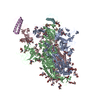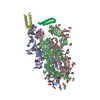+ データを開く
データを開く
- 基本情報
基本情報
| 登録情報 | データベース: PDB / ID: 7zsd | ||||||||||||||||||
|---|---|---|---|---|---|---|---|---|---|---|---|---|---|---|---|---|---|---|---|
| タイトル | cryo-EM structure of omicron spike in complex with de novo designed binder, local | ||||||||||||||||||
 要素 要素 |
| ||||||||||||||||||
 キーワード キーワード | ANTIVIRAL PROTEIN / SARS-COV2 / de novo / design binder / spike / RBD / receptor binding domain | ||||||||||||||||||
| 機能・相同性 |  機能・相同性情報 機能・相同性情報positive regulation of intralumenal vesicle formation / cytoplasmic side of apical plasma membrane / Sealing of the nuclear envelope (NE) by ESCRT-III / imaginal disc-derived wing vein morphogenesis / sensory organ precursor cell division / wing disc morphogenesis / compound eye development / female germ-line stem cell asymmetric division / phosphatidylinositol phosphate binding / sensory organ development ...positive regulation of intralumenal vesicle formation / cytoplasmic side of apical plasma membrane / Sealing of the nuclear envelope (NE) by ESCRT-III / imaginal disc-derived wing vein morphogenesis / sensory organ precursor cell division / wing disc morphogenesis / compound eye development / female germ-line stem cell asymmetric division / phosphatidylinositol phosphate binding / sensory organ development / endosome transport via multivesicular body sorting pathway / apicolateral plasma membrane / endosomal transport / negative regulation of Notch signaling pathway / mitotic cytokinesis / Notch signaling pathway / intracellular protein transport / DNA-binding transcription repressor activity, RNA polymerase II-specific / cell cortex / Maturation of spike protein / viral translation / Translation of Structural Proteins / Virion Assembly and Release / host cell surface / host extracellular space / suppression by virus of host tetherin activity / Induction of Cell-Cell Fusion / structural constituent of virion / entry receptor-mediated virion attachment to host cell / host cell endoplasmic reticulum-Golgi intermediate compartment membrane / receptor-mediated endocytosis of virus by host cell / membrane fusion / Attachment and Entry / positive regulation of viral entry into host cell / receptor-mediated virion attachment to host cell / receptor ligand activity / endosome membrane / DNA-binding transcription factor activity, RNA polymerase II-specific / host cell surface receptor binding / RNA polymerase II cis-regulatory region sequence-specific DNA binding / fusion of virus membrane with host plasma membrane / fusion of virus membrane with host endosome membrane / viral envelope / virion attachment to host cell / regulation of transcription by RNA polymerase II / SARS-CoV-2 activates/modulates innate and adaptive immune responses / host cell plasma membrane / virion membrane / identical protein binding / membrane / nucleus / plasma membrane / cytoplasm / cytosol 類似検索 - 分子機能 | ||||||||||||||||||
| 生物種 |   | ||||||||||||||||||
| 手法 | 電子顕微鏡法 / 単粒子再構成法 / クライオ電子顕微鏡法 / 解像度: 3.29 Å | ||||||||||||||||||
 データ登録者 データ登録者 | Pablo, G. / Sarah, W. / Alexandra, V.H. / Anthony, M. / Andreas, S. / Zander, H. / Dongchun, N. / Shuguang, T. / Freyr, S. / Casper, G. ...Pablo, G. / Sarah, W. / Alexandra, V.H. / Anthony, M. / Andreas, S. / Zander, H. / Dongchun, N. / Shuguang, T. / Freyr, S. / Casper, G. / Priscilla, T. / Alexandra, T. / Stephane, R. / Sandrine, G. / Jane, M. / Aaron, P. / Zepeng, X. / Yan, C. / Pu, H. / George, G. / Elisa, O. / Beat, F. / Didier, T. / Henning, S. / Michael, B. / Bruno, E.C. | ||||||||||||||||||
| 資金援助 | European Union,  スイス, 5件 スイス, 5件
| ||||||||||||||||||
 引用 引用 |  ジャーナル: Nature / 年: 2023 ジャーナル: Nature / 年: 2023タイトル: De novo design of protein interactions with learned surface fingerprints. 著者: Pablo Gainza / Sarah Wehrle / Alexandra Van Hall-Beauvais / Anthony Marchand / Andreas Scheck / Zander Harteveld / Stephen Buckley / Dongchun Ni / Shuguang Tan / Freyr Sverrisson / Casper ...著者: Pablo Gainza / Sarah Wehrle / Alexandra Van Hall-Beauvais / Anthony Marchand / Andreas Scheck / Zander Harteveld / Stephen Buckley / Dongchun Ni / Shuguang Tan / Freyr Sverrisson / Casper Goverde / Priscilla Turelli / Charlène Raclot / Alexandra Teslenko / Martin Pacesa / Stéphane Rosset / Sandrine Georgeon / Jane Marsden / Aaron Petruzzella / Kefang Liu / Zepeng Xu / Yan Chai / Pu Han / George F Gao / Elisa Oricchio / Beat Fierz / Didier Trono / Henning Stahlberg / Michael Bronstein / Bruno E Correia /    要旨: Physical interactions between proteins are essential for most biological processes governing life. However, the molecular determinants of such interactions have been challenging to understand, even ...Physical interactions between proteins are essential for most biological processes governing life. However, the molecular determinants of such interactions have been challenging to understand, even as genomic, proteomic and structural data increase. This knowledge gap has been a major obstacle for the comprehensive understanding of cellular protein-protein interaction networks and for the de novo design of protein binders that are crucial for synthetic biology and translational applications. Here we use a geometric deep-learning framework operating on protein surfaces that generates fingerprints to describe geometric and chemical features that are critical to drive protein-protein interactions. We hypothesized that these fingerprints capture the key aspects of molecular recognition that represent a new paradigm in the computational design of novel protein interactions. As a proof of principle, we computationally designed several de novo protein binders to engage four protein targets: SARS-CoV-2 spike, PD-1, PD-L1 and CTLA-4. Several designs were experimentally optimized, whereas others were generated purely in silico, reaching nanomolar affinity with structural and mutational characterization showing highly accurate predictions. Overall, our surface-centric approach captures the physical and chemical determinants of molecular recognition, enabling an approach for the de novo design of protein interactions and, more broadly, of artificial proteins with function. | ||||||||||||||||||
| 履歴 |
|
- 構造の表示
構造の表示
| 構造ビューア | 分子:  Molmil Molmil Jmol/JSmol Jmol/JSmol |
|---|
- ダウンロードとリンク
ダウンロードとリンク
- ダウンロード
ダウンロード
| PDBx/mmCIF形式 |  7zsd.cif.gz 7zsd.cif.gz | 58.8 KB | 表示 |  PDBx/mmCIF形式 PDBx/mmCIF形式 |
|---|---|---|---|---|
| PDB形式 |  pdb7zsd.ent.gz pdb7zsd.ent.gz | 42.8 KB | 表示 |  PDB形式 PDB形式 |
| PDBx/mmJSON形式 |  7zsd.json.gz 7zsd.json.gz | ツリー表示 |  PDBx/mmJSON形式 PDBx/mmJSON形式 | |
| その他 |  その他のダウンロード その他のダウンロード |
-検証レポート
| 文書・要旨 |  7zsd_validation.pdf.gz 7zsd_validation.pdf.gz | 1.5 MB | 表示 |  wwPDB検証レポート wwPDB検証レポート |
|---|---|---|---|---|
| 文書・詳細版 |  7zsd_full_validation.pdf.gz 7zsd_full_validation.pdf.gz | 1.5 MB | 表示 | |
| XML形式データ |  7zsd_validation.xml.gz 7zsd_validation.xml.gz | 26.8 KB | 表示 | |
| CIF形式データ |  7zsd_validation.cif.gz 7zsd_validation.cif.gz | 35.8 KB | 表示 | |
| アーカイブディレクトリ |  https://data.pdbj.org/pub/pdb/validation_reports/zs/7zsd https://data.pdbj.org/pub/pdb/validation_reports/zs/7zsd ftp://data.pdbj.org/pub/pdb/validation_reports/zs/7zsd ftp://data.pdbj.org/pub/pdb/validation_reports/zs/7zsd | HTTPS FTP |
-関連構造データ
| 関連構造データ |  14930MC  7xadC  7xyqC  7zrvC  7zssC C: 同じ文献を引用 ( M: このデータのモデリングに利用したマップデータ |
|---|---|
| 類似構造データ | 類似検索 - 機能・相同性  F&H 検索 F&H 検索 |
- リンク
リンク
- 集合体
集合体
| 登録構造単位 | 
|
|---|---|
| 1 |
|
- 要素
要素
| #1: タンパク質 | 分子量: 22280.193 Da / 分子数: 1 / 由来タイプ: 組換発現 由来: (組換発現)  遺伝子: S, 2 / 発現宿主:  Homo sapiens (ヒト) / 参照: UniProt: P0DTC2 Homo sapiens (ヒト) / 参照: UniProt: P0DTC2 |
|---|---|
| #2: タンパク質 | 分子量: 8829.904 Da / 分子数: 1 / 由来タイプ: 組換発現 由来: (組換発現)  遺伝子: l(2)gd1, lgd, CG4713 / 発現宿主:  |
| #3: 多糖 | 2-acetamido-2-deoxy-beta-D-glucopyranose-(1-4)-2-acetamido-2-deoxy-beta-D-glucopyranose |
| 研究の焦点であるリガンドがあるか | N |
-実験情報
-実験
| 実験 | 手法: 電子顕微鏡法 |
|---|---|
| EM実験 | 試料の集合状態: PARTICLE / 3次元再構成法: 単粒子再構成法 |
- 試料調製
試料調製
| 構成要素 |
| ||||||||||||||||||||||||
|---|---|---|---|---|---|---|---|---|---|---|---|---|---|---|---|---|---|---|---|---|---|---|---|---|---|
| 分子量 | 値: 0.45 MDa / 実験値: YES | ||||||||||||||||||||||||
| 由来(天然) |
| ||||||||||||||||||||||||
| 由来(組換発現) |
| ||||||||||||||||||||||||
| 緩衝液 | pH: 7.5 | ||||||||||||||||||||||||
| 試料 | 濃度: 1 mg/ml / 包埋: NO / シャドウイング: NO / 染色: NO / 凍結: YES | ||||||||||||||||||||||||
| 試料支持 | グリッドのタイプ: Quantifoil R2/1 | ||||||||||||||||||||||||
| 急速凍結 | 装置: FEI VITROBOT MARK IV / 凍結剤: ETHANE / 湿度: 90 % / 凍結前の試料温度: 298 K |
- 電子顕微鏡撮影
電子顕微鏡撮影
| 実験機器 |  モデル: Titan Krios / 画像提供: FEI Company |
|---|---|
| 顕微鏡 | モデル: FEI TITAN KRIOS |
| 電子銃 | 電子線源:  FIELD EMISSION GUN / 加速電圧: 300 kV / 照射モード: FLOOD BEAM FIELD EMISSION GUN / 加速電圧: 300 kV / 照射モード: FLOOD BEAM |
| 電子レンズ | モード: BRIGHT FIELD / 倍率(公称値): 165000 X / 最大 デフォーカス(公称値): 2000 nm / 最小 デフォーカス(公称値): 800 nm / Cs: 2.7 mm / アライメント法: COMA FREE |
| 試料ホルダ | 凍結剤: NITROGEN 試料ホルダーモデル: FEI TITAN KRIOS AUTOGRID HOLDER |
| 撮影 | 平均露光時間: 5.82 sec. / 電子線照射量: 60 e/Å2 フィルム・検出器のモデル: FEI FALCON IV (4k x 4k) |
| 電子光学装置 | エネルギーフィルター名称: TFS Selectris X |
- 解析
解析
| ソフトウェア | 名称: PHENIX / バージョン: 1.19.2_4158: / 分類: 精密化 | |||||||||||||||||||||||||||||||||
|---|---|---|---|---|---|---|---|---|---|---|---|---|---|---|---|---|---|---|---|---|---|---|---|---|---|---|---|---|---|---|---|---|---|---|
| EMソフトウェア |
| |||||||||||||||||||||||||||||||||
| CTF補正 | タイプ: NONE | |||||||||||||||||||||||||||||||||
| 粒子像の選択 | 選択した粒子像数: 1820333 | |||||||||||||||||||||||||||||||||
| 対称性 | 点対称性: C1 (非対称) | |||||||||||||||||||||||||||||||||
| 3次元再構成 | 解像度: 3.29 Å / 解像度の算出法: FSC 0.143 CUT-OFF / 粒子像の数: 50758 / 対称性のタイプ: POINT | |||||||||||||||||||||||||||||||||
| 原子モデル構築 | B value: 33.8 / プロトコル: AB INITIO MODEL / 空間: REAL | |||||||||||||||||||||||||||||||||
| 原子モデル構築 | PDB-ID: 7QO7 | |||||||||||||||||||||||||||||||||
| 拘束条件 |
|
 ムービー
ムービー コントローラー
コントローラー





 PDBj
PDBj







